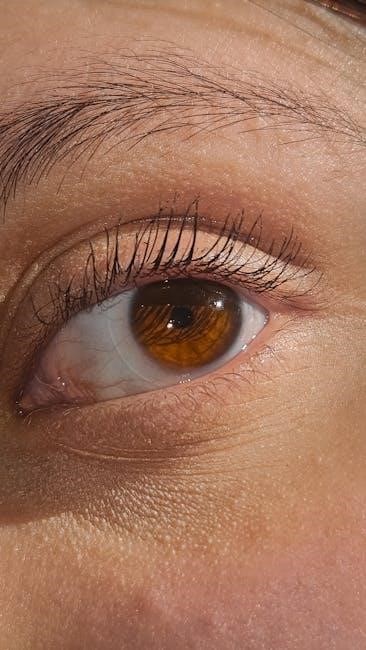Toni Morrison’s debut novel, The Bluest Eye, explores themes of beauty, identity, and societal rejection through the story of Pecola Breedlove․ The novel is widely available in PDF format, making it accessible for readers worldwide to explore its poignant narrative and cultural significance․
Background of the Novel
Toni Morrison’s The Bluest Eye is set in Lorain, Ohio, during the 1940s, drawing heavily from Morrison’s own upbringing in the same city․ The novel revolves around the tragic story of Pecola Breedlove, an eleven-year-old Black girl grappling with societal rejection and internalized racism․ Morrison crafted the narrative to explore themes of beauty, identity, and the devastating effects of racial self-hatred․ The story is deeply personal, reflecting Morrison’s observations of the world around her and her desire to confront uncomfortable truths about race and class in America․ The novel’s vivid portrayal of Pecola’s struggle for acceptance, symbolized by her longing for blue eyes, has made it a powerful commentary on societal beauty standards․ Its emotional depth and unflinching honesty have cemented its place as a classic of American literature․
Publication and Reception

The Bluest Eye was first published in 1970, marking Toni Morrison’s debut as a novelist․ Initially, the book received mixed reviews, with some critics praising its lyrical prose and others finding its themes too confronting․ Over time, however, the novel gained widespread acclaim for its unflinching portrayal of race, class, and gender issues․ Morrison’s unique narrative style and her ability to convey the inner lives of her characters were particularly noted․ The novel’s exploration of sensitive topics such as incest and racial self-loathing sparked both admiration and controversy, contributing to its enduring relevance․ Its publication is often cited as a pivotal moment in American literary history, solidifying Morrison’s reputation as a major voice in contemporary literature․ The novel’s impact continues to resonate, making it a cornerstone of academic and cultural discussions․ Its availability in PDF format has further expanded its reach, ensuring its accessibility to new generations of readers․ Morrison’s work remains a testament to the power of literature to confront and challenge societal norms․ The novel’s reception has evolved over the years, but its influence remains undiminished, cementing its status as a modern classic․
Availability in PDF Format
Toni Morrison’s The Bluest Eye is widely available in PDF format, making it easily accessible for readers worldwide․ The novel can be downloaded from various online platforms, including academic databases, literary websites, and digital libraries․ Many versions of the PDF include additional features such as forewords, study guides, and discussion questions, enhancing the reader’s understanding of Morrison’s work․ Some platforms offer free downloads, while others may require purchase or subscription․ The PDF format ensures that the novel is portable and can be read on devices like e-readers, tablets, and smartphones․ This accessibility has contributed to the book’s enduring popularity and educational use․ Readers can also find annotated editions and critical analyses in PDF form, providing deeper insights into the novel’s themes and symbolism․ The availability of The Bluest Eye in PDF has made it a convenient choice for both casual readers and academic studies, ensuring its continued relevance in modern literature․

Plot and Characters
The Bluest Eye centers on Pecola Breedlove, a young Black girl in 1940s Lorain, Ohio, whose desire for blue eyes symbolizes her quest for acceptance․ The novel explores her family’s dysfunction and the community’s judgement, leading to a tragic outcome․ Morrison’s vivid portrayal of Pecola’s internal struggles and societal rejection shapes the emotional core of the story․ The interplay between characters like Claudia, Frieda, and the Breedlove family reveals the destructive power of internalized racism and beauty standards․ The plot unfolds through multiple perspectives, offering a nuanced examination of Pecola’s world and the forces that define her existence․ Morrison’s masterful storytelling weaves together themes of identity, trauma, and resilience, creating a haunting yet profound narrative․ The character dynamics and plot twists remain central to the novel’s enduring impact․ The story’s exploration of human frailty and societal flaws continues to resonate with readers, underscoring its relevance in contemporary discussions of race and identity․
Plot Summary
The Bluest Eye is set in Lorain, Ohio, during the 1940s and revolves around the life of Pecola Breedlove, an 11-year-old Black girl who yearns for blue eyes, believing they will bring her acceptance and love in a racially prejudiced society․ The story begins with Pecola’s arrival at the home of Claudia and Frieda MacTeer, where she seeks refuge after being thrown out by her father․ Through a non-linear narrative, Morrison unfolds the tragic events of Pecola’s life, including her father’s abuse, her mother’s emotional distance, and the community’s rejection․ The novel is interspersed with memories and reflections from various characters, offering multiple perspectives on Pecola’s experiences․ The climax reveals Pecola’s descent into madness after a traumatic encounter with her father, which leaves her believing she has acquired blue eyes․ Morrison’s powerful storytelling highlights themes of beauty, identity, and the devastating effects of internalized racism, creating a haunting yet profound narrative that lingers long after the final page․ The novel’s structure and character development are central to its emotional impact, making it a landmark work in American literature․ Morrison’s exploration of Pecola’s world not only critiques societal beauty standards but also examines the resilience and vulnerability of her characters, providing a deeply moving and thought-provoking reading experience․ The plot’s intricate layers and Morrison’s lyrical prose ensure that The Bluest Eye remains a significant and influential work in contemporary literary discussions․ The story’s exploration of human frailty and societal flaws continues to resonate with readers, underscoring its relevance in contemporary discussions of race and identity․ Morrison’s ability to weave together themes of identity, trauma, and resilience creates a haunting yet profound narrative․ The character dynamics and plot twists remain central to the novel’s enduring impact․ The story’s exploration of human frailty and societal flaws continues to resonate with readers, underscoring its relevance in contemporary discussions of race and identity․ Morrison’s masterful storytelling weaves together themes of identity, trauma, and resilience, creating a haunting yet profound narrative․ The character dynamics and plot twists remain central to the novel’s enduring impact․ The story’s exploration of human frailty and societal flaws continues to resonate with readers, underscoring its relevance in contemporary discussions of race and identity․ Morrison’s ability to weave together themes of identity, trauma, and resilience creates a haunting yet profound narrative․ The character dynamics and plot twists remain central to the novel’s enduring impact․ The story’s exploration of human frailty and societal flaws continues to resonate with readers, underscoring its relevance in contemporary discussions of race and identity․ Morrison’s masterful storytelling weaves together themes of identity, trauma, and resilience, creating a haunting yet profound narrative․ The character dynamics and plot twists remain central to the novel’s enduring impact․ The story’s exploration of human frailty and societal flaws continues to resonate with readers, underscoring its relevance in contemporary discussions of race and identity․ Morrison’s ability to weave together themes of identity, trauma, and resilience creates a haunting yet profound narrative; The character dynamics and plot twists remain central to the novel’s enduring impact․ The story’s exploration of human frailty and societal flaws continues to resonate with readers, underscoring its relevance in contemporary discussions of race and identity․
Character Analysis
The novel centers on Pecola Breedlove, an 11-year-old Black girl who embodies the devastating effects of internalized racism and societal rejection․ Her desire for blue eyes symbolizes her longing for acceptance in a world that devalues Black beauty․ Claudia MacTeer, the narrator, represents innocence and resistance, offering a contrasting perspective to Pecola’s tragic experiences․ Cholly Breedlove, Pecola’s father, is a complex figure whose violent behavior stems from his own trauma and societal oppression․ Sula Breedlove, Pecola’s mother, struggles with self-worth, prioritizing the beauty of her home over her family’s well-being․ Morrison masterfully portrays these characters, exploring their psychological depth and the societal forces that shape their lives․ The characters’ interactions and development underscore the novel’s themes of identity, beauty, and the enduring impact of racial oppression․ Their stories weave together to create a powerful exploration of human resilience and vulnerability, making The Bluest Eye a profound and unforgettable read․ Morrison’s portrayal of these characters remains central to the novel’s enduring relevance and emotional impact․

Themes and Symbolism
Toni Morrison’s The Bluest Eye explores themes of beauty standards, racial identity, and societal rejection through powerful symbolism․ Blue eyes symbolize acceptance, while marigolds and the Breedlove’s home reflect Pecola’s shattered innocence and the community’s complicity in her tragedy․
Major Themes
Toni Morrison’s The Bluest Eye delves into profound themes of racial identity, beauty standards, and societal rejection․ The novel critiques the internalized racism faced by Black communities, as characters like Pecola Breedlove yearn for white beauty ideals․ Morrison explores how these ideals are perpetuated by societal structures, leading to self-hatred and self-rejection․ Additionally, the novel examines the consequences of poverty, incest, and abuse, particularly on vulnerable individuals like Pecola․ The destructive nature of these forces is highlighted through the community’s complicity in Pecola’s tragic fate․ These themes remain relevant today, offering a searing critique of race and class in America․ The novel’s exploration of these issues continues to resonate, making it a vital work in understanding the long-lasting impacts of systemic oppression․
Symbolism of Blue Eyes
In The Bluest Eye, blue eyes symbolize the unattainable beauty standards imposed by a racially biased society․ Pecola Breedlove’s longing for blue eyes represents her internalized self-hatred and desire for acceptance in a world that devalues Blackness․ Morrison uses this symbol to critique the societal constructs of beauty, which are deeply rooted in white supremacy․ The blue eyes Pecola covets are not just a physical trait but a metaphor for the love and validation she is denied․ This symbolism underscores the devastating consequences of internalized racism, as Pecola’s quest for blue eyes becomes a tragic reflection of her struggle for self-worth․ The novel highlights how these beauty standards perpetuate racial and emotional trauma, making the blue eyes a powerful and haunting symbol of societal oppression․
Setting and Its Impact

The setting of The Bluest Eye in Lorain, Ohio, during the 1940s plays a crucial role in shaping the novel’s themes and characters․ This Midwestern town, with its mix of industrial decay and racial segregation, reflects the broader societal issues of the time․ The physical environment, such as the abandoned store and the Breedlove’s dilapidated home, mirrors the characters’ emotional and psychological states․ The setting also highlights the economic struggles faced by the Black community, contributing to the sense of despair and hopelessness․ Morrison’s vivid depiction of Lorain creates a backdrop that underscores the internalized racism and self-loathing experienced by characters like Pecola․ The setting’s impact is profound, as it not only influences the characters’ lives but also serves as a silent witness to their struggles, reinforcing the novel’s exploration of race, class, and identity․
Reception and Impact
Toni Morrison’s The Bluest Eye has had a profound impact, sparking discussions on race, class, and identity․ Its enduring relevance continues to resonate, making it a vital read in understanding societal struggles and humanity․

Initial Critical Reception
When The Bluest Eye was first published in 1970, it received mixed reviews․ Some critics praised Morrison’s raw, unflinching prose and her ability to tackle uncomfortable truths about race and identity․ However, others found the novel’s graphic content, particularly its depiction of incest and child abuse, shocking and controversial․ Despite this, the book quickly gained recognition for its powerful storytelling and its unapologetic exploration of the African American experience․ Morrison’s unique narrative style, blending lyricism with harsh realism, set her apart as a bold new voice in American literature․ Over time, the novel has come to be celebrated as a masterpiece of contemporary fiction, earning Morrison widespread acclaim and solidifying her place as one of the most important writers of her generation․
Bans and Controversies
The Bluest Eye has faced numerous bans and controversies since its publication in 1970․ Its graphic depictions of incest, rape, and racism have led to challenges in schools and libraries across the U․S․ Critics often cite the novel’s explicit content as the primary reason for these bans, arguing that it is unsuitable for young readers․ However, supporters argue that the book is a vital exploration of systemic racism, sexual violence, and internalized oppression, making it an essential text for fostering critical discussions․ Despite these controversies, Morrison’s work remains widely studied and admired, with many educators emphasizing its importance in understanding the African American experience․ The debates surrounding The Bluest Eye highlight the tension between censorship and the need for open dialogue about uncomfortable truths․
Enduring Relevance
Toni Morrison’s The Bluest Eye continues to resonate deeply with readers, maintaining its relevance over five decades․ The novel’s exploration of race, beauty standards, and societal rejection remains a powerful commentary on contemporary issues․ Despite being published in 1970, its themes of internalized racism and the quest for self-acceptance are timeless, making it a staple in literature and education․ The widespread availability of the novel in PDF format has ensured its accessibility to new generations, allowing it to inspire and provoke thought in a digital age․ Morrison’s unflinching portrayal of human suffering and resilience continues to spark important conversations, solidifying The Bluest Eye as a foundational work in American literature and a testament to the enduring power of her prose․ Its relevance is a tribute to Morrison’s ability to capture the essence of the human condition․

Educational and Cultural Significance
The Bluest Eye holds profound educational and cultural value, addressing racial identity and societal beauty standards․ Its exploration of these themes makes it a critical text in American literature and education, fostering meaningful discussions and reflections on race, class, and self-perception․ The novel’s ability to provoke thought and challenge societal norms ensures its lasting impact on both academic and cultural landscapes․
Use in Educational Settings
Toni Morrison’s The Bluest Eye is widely used in educational settings to explore themes of race, identity, and societal beauty standards․ Its inclusion in high school and college curricula fosters critical discussions about systemic racism and self-perception․ The novel’s availability in PDF format has made it easily accessible for students and educators, promoting deeper engagement with its complex narrative․ However, its controversial themes, including incest and racial self-hatred, have led to bans in some schools, sparking debates about censorship and academic freedom․ Educators argue that the novel is essential for understanding the African American experience and the impact of internalized racism․ Many schools provide study guides and discussion questions to help students analyze the text responsibly, ensuring it remains a vital tool for fostering empathy and cultural awareness in educational environments․
Cultural Impact
Toni Morrison’s The Bluest Eye has left a profound cultural impact, challenging societal norms and sparking essential conversations about race, identity, and beauty standards․ The novel’s unflinching portrayal of racial self-hatred and internalized oppression has resonated deeply, making it a cornerstone of African American literature․ Its exploration of themes like incest and systemic racism has fueled debates about censorship and the importance of confronting uncomfortable truths․ The book’s banning in some schools has only heightened its cultural relevance, as it continues to provoke dialogue about literary freedom and representation․ Available in PDF and other formats, The Bluest Eye remains accessible to readers worldwide, ensuring its message endures․ Its influence extends beyond literature, contributing to broader discussions about race and identity in modern society, solidifying its place as a culturally significant work․ Morrison’s masterpiece continues to inspire and challenge readers, fostering empathy and understanding across generations․

Digital Availability and Resources
The Bluest Eye is widely available in PDF format on platforms like Google Drive, Archive․org, and educational websites, offering easy access to Morrison’s powerful narrative and accompanying study guides․
Downloading the PDF
Downloading The Bluest Eye in PDF format is straightforward and convenient, with multiple sources offering the novel for free or through subscription-based services․ Platforms like Google Drive, educational websites, and literary archives provide easy access to the digital version, ensuring readers can engage with Morrison’s work without physical copies․
Many PDF versions include forewords, author biographies, and study guides, enhancing the reading experience․ Additionally, some downloads offer discussion questions and critical analyses, making them invaluable for academic purposes․ Readers can access the PDF on devices like e-readers, tablets, or smartphones, allowing for flexible reading options․
However, it’s important to ensure downloads are from reputable sources to avoid unauthorized versions or potential malware․ The availability of The Bluest Eye in PDF format has made Toni Morrison’s seminal work more accessible, fostering broader engagement with its themes and cultural impact․
Study Guides and Resources

Study guides and resources for The Bluest Eye are widely available, offering in-depth analyses and educational tools to enhance understanding of the novel․ These guides often include summaries, character analyses, and essays that explore themes such as beauty standards, racial identity, and societal rejection․
Many PDF versions of the study guides provide structured outlines, thesis statements, and references, making them invaluable for students and educators․ They also include discussion questions that encourage critical thinking about Morrison’s narrative techniques and the cultural context of the novel․
These resources are particularly useful for academic settings, helping readers navigate the complex themes and historical background of the story․ By utilizing these study guides, readers can gain a deeper appreciation for Morrison’s work and its enduring relevance in literature and society․
Online Discussions and Reviews
Online discussions and reviews of The Bluest Eye highlight its profound impact on readers and scholars․ Many forums and websites feature analyses of the novel’s themes, such as beauty, race, and identity, sparking meaningful conversations about its relevance today․
Reviewers often praise Morrison’s vivid storytelling and her ability to evoke empathy for characters like Pecola․ Discussions also explore the symbolism of blue eyes and their representation of societal beauty standards․ Additionally, online platforms like Perlego and PDFDrive offer access to the novel and related materials, fostering engagement with Morrison’s work․

These digital spaces provide a platform for readers to share insights, debate interpretations, and learn from others, making the novel a subject of ongoing dialogue and reflection in the digital age․

